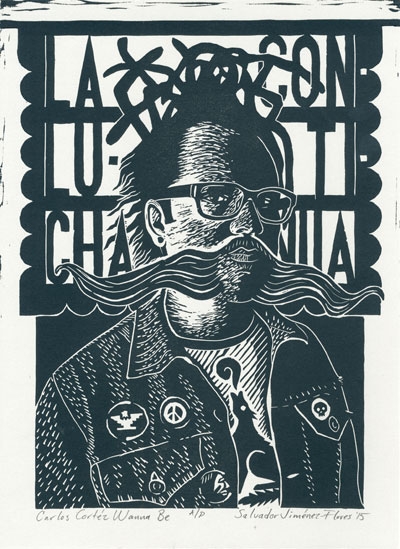Salvador Jiménez-Flores says his work is inspired by his multiculturalism and the need to communicate — two pivotal aspects of the artist’s life. Since moving to the United States in 2000 from Jalisco, Mexico he has created several socially-conscious installations as well as studio-based and public art. His work can be seen at the National Museum of Mexican Art in Chicago, Casa De La Cultura in Texas, Koehnline Museum of Art in Illinois, and locally at the Grand Rapids Art Museum and the Urban Institute for Contemporary Art. He received his Masters of Fine Arts from Kendall College of Art and Design and starts a year-long artist-in-residence position at Harvard University this month.
What began your process of becoming an artist?
I migrated to the United States when I was 15 years old. I didn’t know any English and I started high school soon after my arrival. Those first years were difficult as I was trying to adapt to a new culture with a language I didn’t know. I took a photography class my second summer and it was then that art making became my coping mechanism during my adaptation to the U.S.
You work within many mediums — drawings, installations, paintings, print-making, found objects — is there one you find yourself gravitating towards more often?
I’m an interdisciplinary artist and I like to take risks with my art so I’m constantly trying to learn a new skill or technique—add them to my tool box. I like them all. However, drawing is always present in my work and clay is a material that I recently started working with and I find it fascinating. The way I approach clay is the same way I approach drawing—I let my hands roam free allowing intuition and spontaneity to happen.
Your artist statement says that because you are bilingual and bicultural you live in two different worlds. How does this affect your art?
The feeling of being in two places is a feeling shared with anyone who has migrated to a different city or country. I live concurrently in two worlds. Neither my adaptation to a foreign land nor the return to my motherland will ever be complete. Anywhere, I’m a foreigner. These experiences have encouraged me to research and understand the connection between the two worlds that I live in: México and U.S.A.
You describe yourself as an activist, do you believe art can inspire activism and vice versa?
The content of my work is sociopolitical and is driven by my powerful life experiences. It deals with immigration, identity, culture, injustice, language, and religion. I have observed inequality, discrimination and oppression in México, as well as in the United States. As an artist I feel I have the responsibility to address the issues that affect my community and to create awareness and propose actions through my art. I’m an artist and an activist that believes in the power of art. Art and activism go well together and they need each other. I personally make art that challenges comfort and makes the audience think and question their stand on certain issues.
What’s your artistic process?
My creation process is a combination of head, heart and hands. Everything I do is integrated into who I am: What I like and dislike, the books I chose to read, the music I listen to, the memories I keep, the historical events that shape me, my surroundings and my relationships.
In what ways do the past and historic events inspire your work?
I believe it is very important to understand where we come from and embrace our histories and ancestors. All of those events and people had to come before us to make our time on earth possible. This is the reason why a lot of my work deals with the self. Identity is an ongoing process of self-discovery and transformation that is complex, contradictory and challenging. Naturally, one’s identity evolves as the context changes. I don’t want to be stigmatized and put in a category. I want to continue exploring who I am, but in an environment that goes beyond flags, languages, cultures and society’s ideals.
What are the best and worst aspects of being an artist in the Grand Rapids area?
Best: The city is an affordable place to live in and it has lots of natural areas to explore. The city is small, clean and easy to navigate. Chicago and Detroit are our neighbors and the creative community continues to grow. Worst: Unfortunately, there is a lack of diversity and inclusion, organizations and people like to play things safe and avoid taking risks. If you don’t look like the dominant culture, most likely you will frequently be questioned, “Where are you from?” And sometimes they won’t believe you and will ask you again, “No, but what country?”
For more information, visit salvadorjimenezflores.com.





